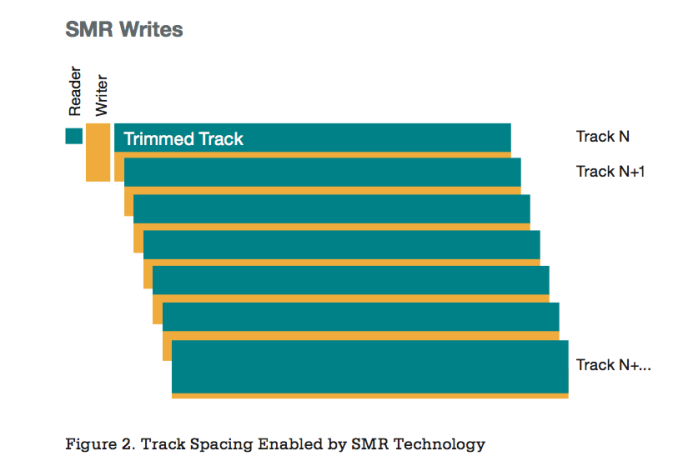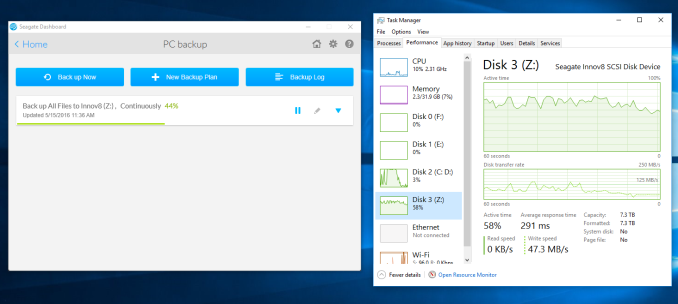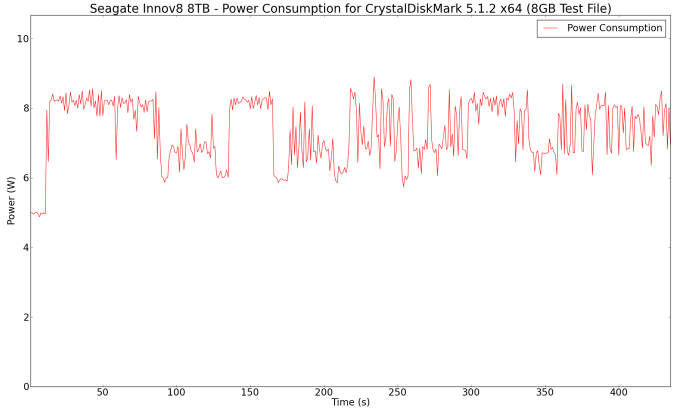Seagate Innov8 8TB Bus-Powered External Hard Drive Review
by Ganesh T S on May 19, 2016 8:30 AM ESTPerformance Consistency, Power and Thermal Characteristics
Shingled Magnetic Recording (SMR) presents a number of challenges when it comes to performance consistency. HDDs featuring shingled recording write new magnetic tracks that overlap part of the previously written tracks. By definition, this slows down write performance since the architecture requires HDDs to rewrite adjacent tracks after any writing operation. The Archive HDD uses drive-managed SMR, and this means that the firmware has been tweaked to ensure optimal performance using caching in the DRAM and even media caches.
In order to show the effect of the firmware on the performance of a SMR drive, let us first take a look at our performance consistency test for the Seagate Archive HDD CTU (clinical trial unit) that Segate provided us last year. That sample had firmware version AR13. As a reminder, our performance consistency test takes the robocopy benchmark described in the previous section and instruments it to record the drive temperature as well as instantaneous transfer rates during the process.
The Archive HDD in the Seagate Innov8 has firmware RT17 and is also behind a USB 3.1 Gen 1 - SATA bridge (unlike the direct SATA connection for the CTU numbers presented above). The performance consistency graph for the Seagate Innov8 is presented below.
Note that some of the issues still remain (such as writes slowing down after a lot of data has been dumped into the drive within a short time span and reads of recently written data being slow). However, they have been mitigated to a large extent. Users with average workloads are unlikely to frequently encounter issues similar to what we saw above, though it is not outside the realms of possibility as shown in the backup process screenshots below. We did confirm that this was not due to varying file sizes, but, do reflect our observations from the robocopy tests in the previous section.
Backups start off around 100 MBps, but slow down to around 50 MBps mid-way
Despite the lack of ventilation for the drive, the contact of the HDD with the metal shield and the aluminum chassis, combined with the low-power nature of the Archive HDD, ensure that the drive keeps reasonable temperatures even in our stress test. The maximum temperature we observed was only 45 C.
Evaluation of the power consumption of the Seagate Innov8 was done using Plugable's USBC-TKEY. Our test procedure and setup are outlined here. We track the power consumed by the drive during the course of the CrystalDiskMark benchmark.
Analyzing the power numbers for the Innov8 is tricky, as the power consumption is monitored at the USB interface. In order to get an additional data point, we also performed the power consumption measurement when processing the AnandTech DAS suite. It includes the PCMark 8 storage bench which involves drive conditioning.
These results show that the drive is subject to much more stress with the DAS suite, with power numbers often spiking upwards of 10W. At idle, the drive can go down to 5W, but, even then, we see spikes up to 6W which might be indicative of housekeeping duties associated with SMR management.
The graphs above also include the power consumed to charge the internal battery. Our experiments show that the Innov8 can take full advantage of ports that can deliver more than 7.5W of power to juice up the internal battery faster. The presence of the battery also ensures that any sudden spike in power requirements can be handled as long as the USB port can deliver 7.5W.

















41 Comments
View All Comments
chekk - Thursday, May 19, 2016 - link
Ganesh, any idea if the firmware used in this version is also present in the latest standard Archive models? I tried out an internal 8TB last year and was impressed until a large sequential write slowed to < 10 MB/s and didn't really recover.ganeshts - Thursday, May 19, 2016 - link
I believe Seagate tunes firmware depending on where the drive is going to end up (i.e., firmware on the external drive models will differ from what is offered for archival purposes - the standalone SATA drives).I will ask Seagate whether it is possible to update the firmware on the CTUs that I received last year. FWIW, the Seagate website says it is not possible to upgrade the firmware on any of the ST8000AS0002 models.
eddieobscurant - Thursday, May 19, 2016 - link
Yes it is. I have 2 archive 8tb from 6 months ago with fw ver AR15 and bought another 2 last week with fw ver AR17, although as ganesh said seagate doesn't provide a way to upgrade the fw to my old ones.I ran a few quick benches (atto, crystal disk mark, etc) between the 2 fw versions without noticing any differences
treecrab - Thursday, May 19, 2016 - link
Ganesh,About large file transfer slowdown: it might be a Windows quirk. I've noticed it on machines with largish (32GB) amount of memory. Basically, when writing several large files, Windows starts to push next file in queue while previous is still being flushed from cache, resulting in disk trashing. It's not very noticeable on a regular harddrive, but on SMR it is going to be bad. Can you repeat that large file writing test but from Linux? Or pull memory out from you windows machine so it can't cache so much?
ganeshts - Thursday, May 19, 2016 - link
It is the same test that works perfectly fine on a large number of other DAS units that I have reviewed [ for example, here: http://www.anandtech.com/show/10208/lacie-porsche-... ] - so, I am quite positive the slowdown has got to do with SMR. Btw, ref. caching - the files are transferred from / transferred to a RAM drive so that the aspect of the source disk speed is negated, and we are testing pure external drive performance.Also, in modern machines, users are definitely going to have large amounts of memory - our testing is as much real-world as it can be :)
treecrab - Thursday, May 19, 2016 - link
Sure, as I said, it's not noticeable (only audible) on regular drives. My point is that the problem is not with SMR alone, but with the way Windows interacts with it. And I'm not disputing test results or they applicability to real world scenarios (although Linux and Mac users might find the drive behaving differently). I'm more interested in finding a good explanation for the phenomenon, hence my cache hypothesis. Other way to check - simply write only one, but humongous file instead of several merely huge ones - If I'm right, there will be no drastic slowdowns (except for usual inner cylinder slump)bananaforscale - Thursday, May 19, 2016 - link
As far as I know it's even more of a problem on Linux.hlmcompany - Thursday, May 19, 2016 - link
My use for bus-powered drives requires that they be portable. Unfortunately, this 3.5" drive is not suited for such a purpose.MrSpadge - Thursday, May 19, 2016 - link
Seagate is not aiming this at replacing every other external drive.adityarjun - Thursday, May 19, 2016 - link
What happens 3 years down the lone when the battery can no longer hold any charge? WIll it be easily replaceable? Will seagate still manufacture these batteries or are they gonna do a Motorola and refuse to repair them? What about 10 years down the line.The battery component seems to be a huge risk.